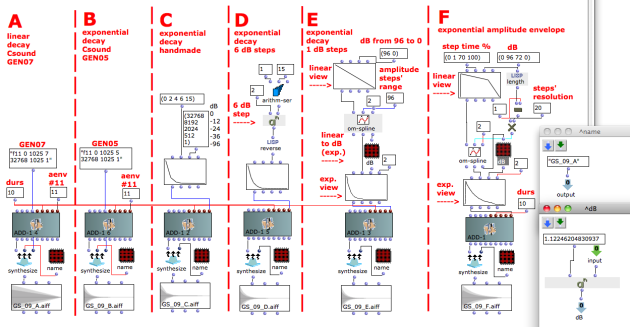Exponential Amplitude Envelope with a BPF
Tutorial Getting Started 09 - Exponential Amplitude Envelope with a BPF
The Tutorial Getting Started 03 - Amplitude_Envelope explains how to give a Break Point Function (BPF) as an amplitude envelope to a OMChroma synthesis class. The amplitude is, however, a magnitude expressed in an exponential scale, the decibel scale. The BPF class, however, gathers the values in a linear way. This chapter displays many strategies to use a BPF with an exponential scale.
- The example A uses the Csound's GEN07 (the GEN function initialized in the add-1 class), which constructs functions from straight, lineraly interpolated segments. Since 32768 is the maximum absolute value with 16 bit depth, this corresponds to a linear decay of 96 dB.
- The example B uses the Csound's GEN05, which constructs functions from segments of exponential curves. This corresponds to an exponential decay of 96 dB. However, since the GEN05 cannot end at zero (0) a very light click will be produced at the end of every component.
- In the example C the values of the decay are directly typed as X and Y coordinate points. The numbers on the list are equivalent to dB values of 0, -12, -24, -36, -96.
- In the example D every step is 6 dB wide (doubling a value corresponds to 6 dB).
- In the example E every step is 1 dB wide (the number 1.12246204830937 inside the subpatch dB is the multiplication factor corresponding to 1 dB).
- The example F is a method to build an exponential amplitude envelope. The "steps" resolution parameter allows to specify the numbers of steps between each segment of the envelope.
Only the GEN05 function generated a perfectly exponential curve whose steepness depends on the interval between the first and the last value (see the Csound documentation for further information). On the other hand, the segment between the points of the curve in the BPF is always linear. Hence, these examples give approximate curves, but listen to them to find the difference!
Watch out at the kind of GEN function
To summarize, the envelopes can built in two ways :
- with an f-table given directly to the :tables key word of synthesize and recalled by its number in the OMChroma object's envelope input slot aenv (Tutorial Getting Started 03 -_Amplitude_Envelope),
- with a BPF connected to the OMChroma object's envelope input slot aenv (Tutorial Getting Started 03 -_Amplitude_Envelope).
With the first method you can change the GEN's type (so if an OMChroma's slot has been initialized with a GEN07 you can give a GEN05)
With the second method the data of the BPF will be usually converted to a GEN07.
All the OMChroma slots that are connected to envelopes (Csound GEN functions) end with "env". However, this does not include slots that read audio files into tables (GEN01).
OMChroma also has classes that allow to specify f-tables directly (ex. GEN07, GEN-07, GEN05, etc.). Their usage will be explained in the next chapter.
- OMChroma User Manual
- System Configuration and Installation
- Getting started
- Class Input Slots
- Slots' Description and Default Values
- Amplitude and Internal Editor
- Amplitude Envelope
- f-GEN Reserved Numbers
- Audio Waveforms
- Chord-seq to OMChroma
- Spectrum Chord and Arpeggio
- Velocity versus Amplitude
- Exponential Amplitude Envelope with a BPF
- Relationship with the Csound .orc and .sco files
- Slots polymorphism
- Managing GEN function and sound files
- Predefined Classes
- User-fun
- Creating a new Class
- Multichannel processing
- Appendix A - Common Red Patches

